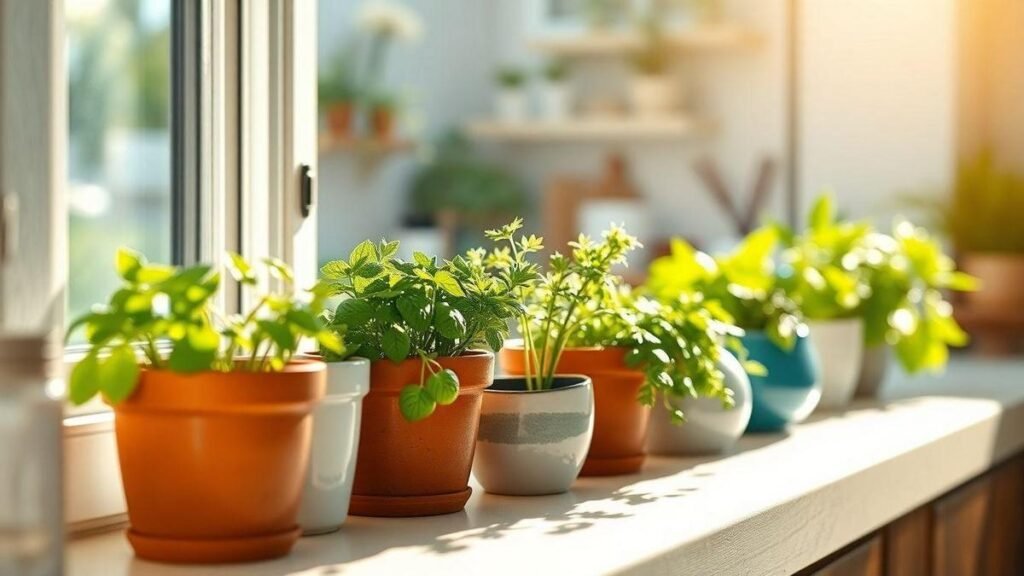Herbs for culinary use in windowsill gardens
Herbs for culinary use in windowsill gardens is my happy place — a tiny kitchen garden that saves grocery runs and upgrades dinner. I’ll show how I pick the best leaves for small spaces, set up pots and drainage, manage light and watering, and start herbs from seeds and cuttings. Expect short, funny, useful tips you can try on your own sill.
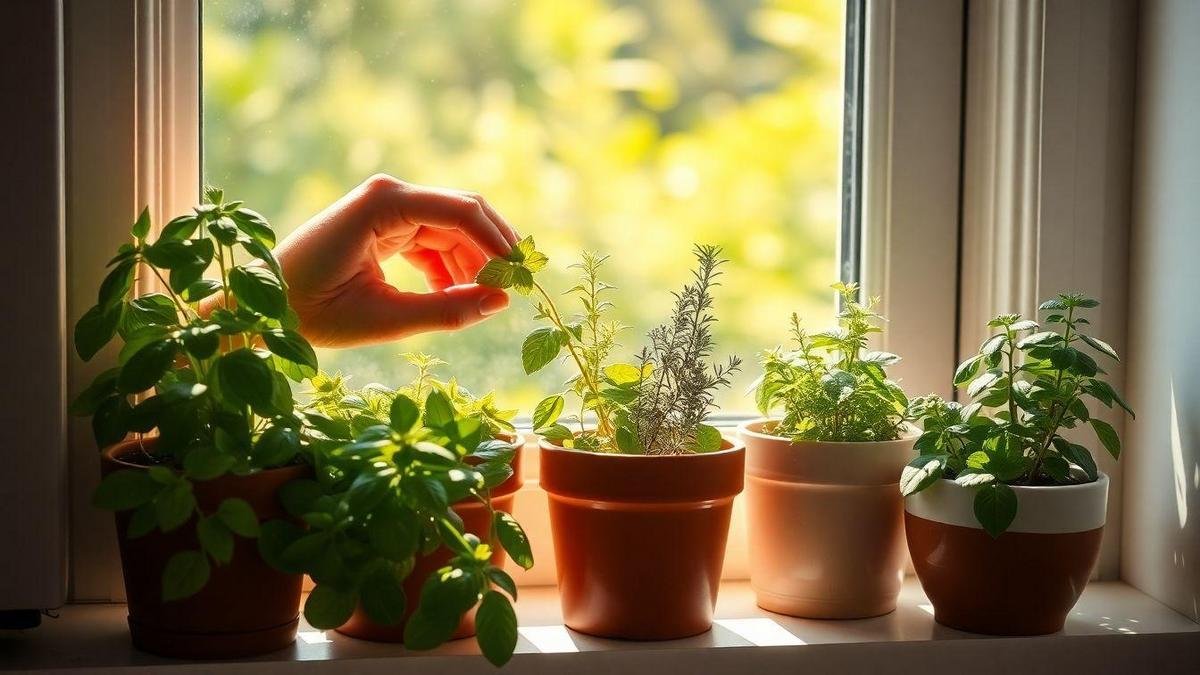
Key takeaway
- I grow basil for pasta and pesto.
- I snip mint for tea; I feel fancy.
- I keep rosemary for roasts and bragging rights.
- I plant chives for instant garnish.
- Water a little when the top inch of soil is dry — happy herbs, happy me.
How I pick the best herbs for windowsill gardens
I choose herbs by light, pot size, and how much fuss they demand. Taste-testing helps too — my kitchen is part garden, part snack bar. For compact spaces, favor plants that are forgiving, productive, and tasty: these are ideal for the best herbs to grow in your kitchen and small sills.
Why basil makes pasta happier
Basil smells like summer and forgives forgetfulness.
- Give bright, direct sunlight (4–6 hours).
- Use a wide pot so roots can stretch.
- Water when the top inch of soil is dry. Pinch tops weekly to keep the plant bushy and harvest-ready. Fresh basil on pasta wakes it up like a good joke.
Parsley — steady and versatile
I prefer flat-leaf parsley for stronger flavor.
- Plant in a deep pot; keep soil evenly moist.
- Cut stems from the outside to keep the crown healthy. Parsley is slow at first, then generous.
Best herbs for windowsill gardens I recommend
| Herb | Light | Pot size | Water | Quick note |
|---|---|---|---|---|
| Basil | 4–6 hrs sun | Medium-wide | Let top inch dry | Fast grower |
| Parsley | 3–4 hrs bright light | Deep | Keep evenly moist | Slow starter |
| Chives | 3–5 hrs sun | Small-medium | Moderate | Snip for onion flavor |
| Mint | 2–4 hrs bright | Medium (contain root) | Keep moist | Spreads fast; pot only |
| Thyme | 4–6 hrs sun | Small | Low-moderate | Drought-tolerant |
| Rosemary | 6 hrs sun | Medium-deep | Low | Likes dry root zone |
I bold the herbs on my plan and move pots like chess pieces. If a plant sulks, try a sunnier square.
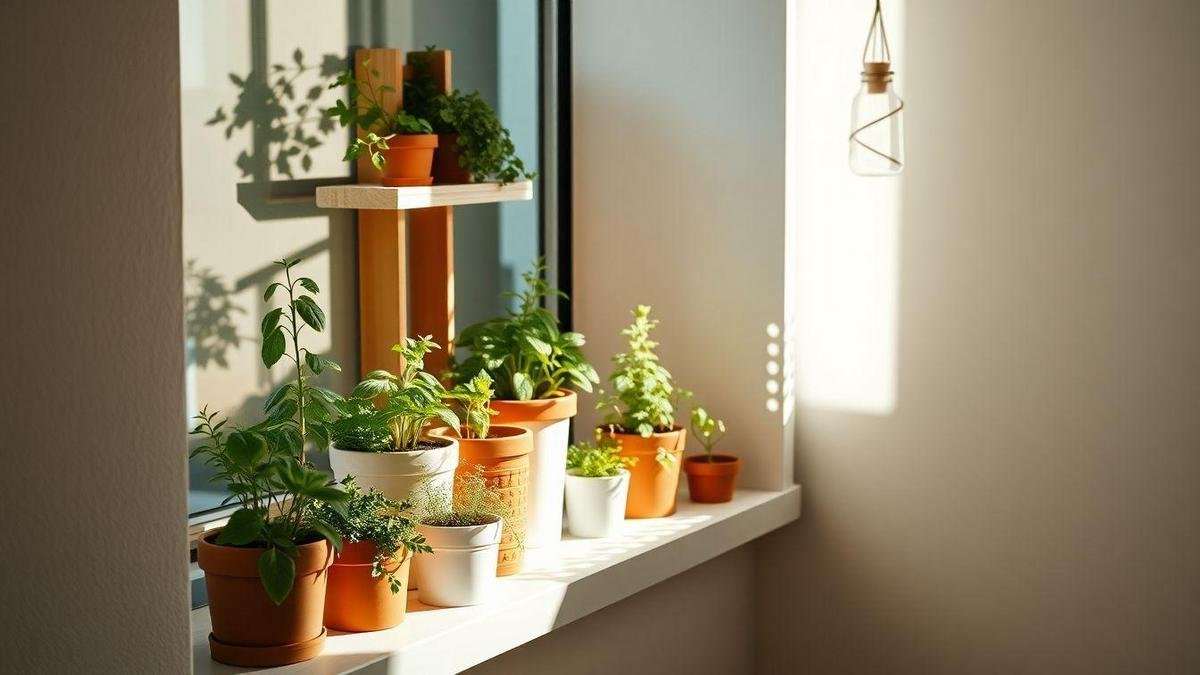
How I fit an herb garden into tiny spaces
I line the sill with small pots, a shallow tray to catch drips, and a vertical shelf when I need more room. Keep it simple so you can grab herbs while cooking. For ideas on maximizing small areas, I often lean on tips for growing plants in small spaces and the best choices for city balconies.
| Item | Best for | Quick tip |
|---|---|---|
| Small pots (3–4″) | Single herbs like chives or thyme | Rotate weekly for even light |
| Shallow tray | Grouping seedlings, catching overflow | Keeps mess down |
| Vertical shelf / hanging pot | Add more plants without losing sill space | Put shade lovers low |
I mix clay (breathes) and plastic (holds water) pots based on each plant’s thirst. For clever container ideas and repurposing things, try a few hacks from ways to reuse household items for gardening.
How I choose culinary herbs that fit and flourish
Pick by light, size, and how often you cook with them. Compact, forgiving, tasty herbs are winners for windowsill herb gardens: basil, chives, parsley, thyme, mint (potted alone), and compact oregano or dwarf basil varieties.
Drainage and pot-size tips
Good drainage is the secret sauce. No hole? No go. Use liner pots or drill holes. If absolutely no hole, a thin pebble layer helps, but it’s a poor substitute.
- Use pots with drainage holes for most herbs.
- 3–4″ pots for chives, thyme, small parsley.
- 6–8″ pots for basil or mint clumps.
- Water when the top 1″ of soil feels dry.
For the right mixes and medium recommendations for containers, see a guide to the best soil mix for container plants. To prevent common moisture mistakes, check how to prevent overwatering and underwatering.
| Herb | Pot size I use | Drainage note |
|---|---|---|
| Chives | 3–4″ | Quick-dry soil |
| Basil | 6″ | Steady moisture; good hole needed |
| Mint | 6–8″ | Needs space and strong drainage |
Soggy soil = sad herbs. After watering, lift the pot to check the saucer; drain excess.
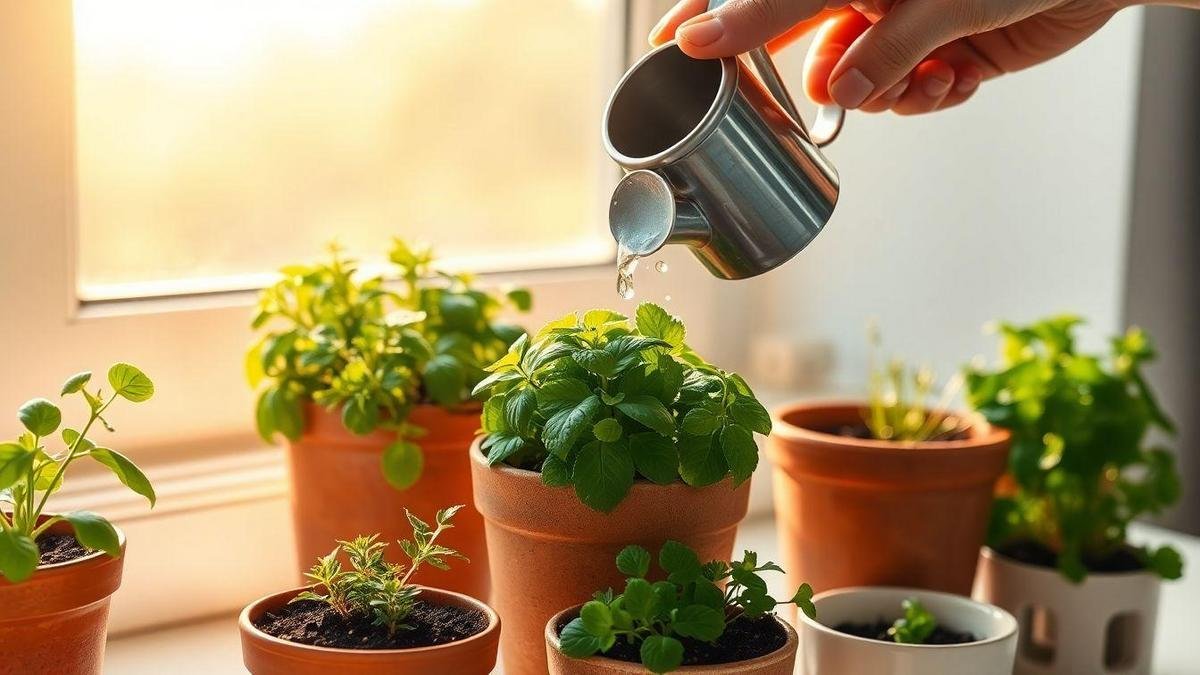
Watering and light — practical rules I follow
Treat the sill like real estate: south = sun lovers, east = morning lovers, north = shy herbs. Rotate pots a quarter turn each week.
- Water when the top inch is dry. Check with your finger.
- Water until runoff, then let drain. Small pots = smaller, more frequent drinks.
- Use well-draining potting mix. No soggy soup for roots.
- Add a small grow light for 4–6 hours if natural light is weak — I rely on recommendations for indoor grow lights.
- Avoid overcrowding; airflow prevents disease. Use reflective surfaces to boost weak light with tips from how to use reflective surfaces.
Quick schedule:
- Small pots (2–4″): ~every 3–5 days in warm months.
- Medium (4–6″): ~every 5–7 days.
Adjust for heat, humidity, and sun.
Signs of overwatering vs underwatering
I read leaves like signals:
- Overwater: yellow, soft leaves, wet soil for days, mold or sour smell, brown mushy roots.
- Underwater: dry, crispy tips, wilting that perks after watering, soil pulling from pot edges.
Fixes:
- Overwater: stop watering, move to bright air, repot if roots are rotten — see how to fix yellow leaves on plants for common yellowing causes.
- Underwater: soak pot in shallow tray for 20 minutes, then drain.
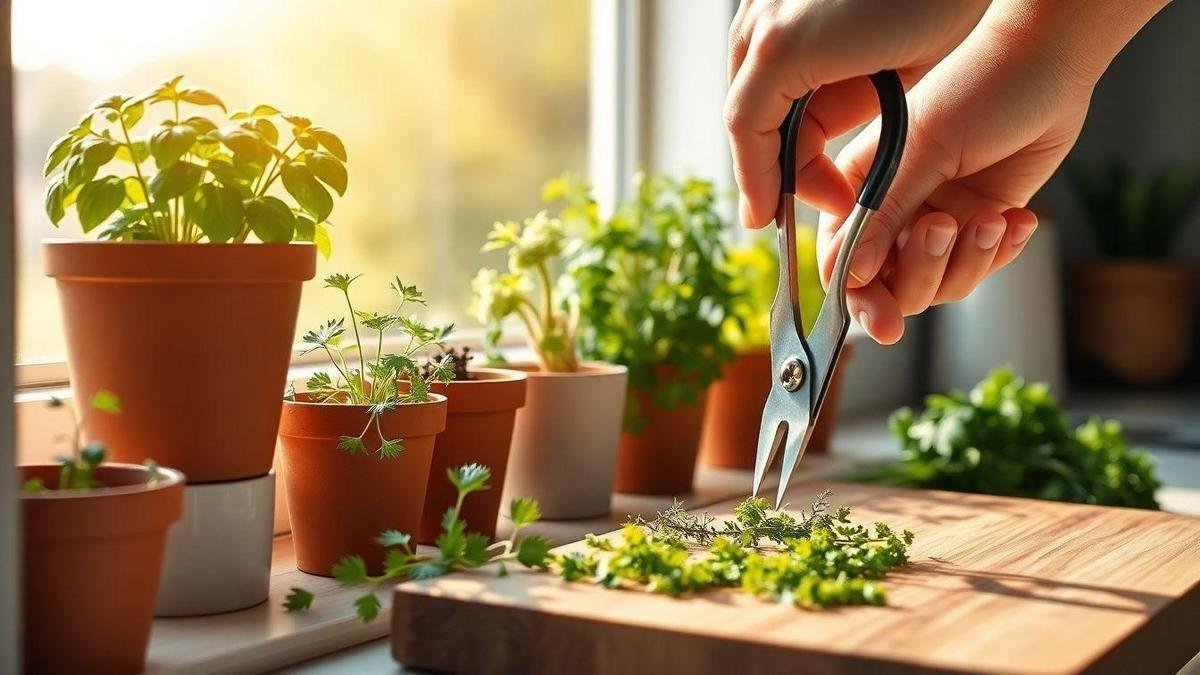
How I use herbs in cooking
I harvest often and cook immediately. Fresh leaves beat store-bought for flavor.
Fresh basil — sauces, salads, pesto
- Pick a handful twice a week.
- Harvest from the top to keep it bushy; remove flower buds; pick in the morning for best oils.
Uses: add at the end of sauces, chiffonade over salads, blitz into pesto.
Parsley, thyme, rosemary — everyday workhorses
- Parsley — fresh, grassy; snip outer stems near base.
- Thyme — earthy and lemony; cut sprigs and strip leaves.
- Rosemary — piney and strong; snip woody stems and use sparingly.
| Herb | Light | Watering | Flavor & common uses | How I harvest |
|---|---|---|---|---|
| Parsley | Bright light | Keep moist | Fresh, grassy — salads, garnishes | Snip outer stems |
| Thyme | 6–8 hrs sun | Let top dry a bit | Earthy — stews, roast | Cut sprigs, strip leaves |
| Rosemary | 6–8 hrs sun | Sparing water | Piney — roasts, bread | Snip woody stems |
Harvesting techniques to keep herbs productive
- Pinch tops regularly to stop legginess.
- Cut above a node so new shoots grow.
- Don’t strip more than a third at once.
- Use clean scissors; dry or freeze extras in olive oil cubes.
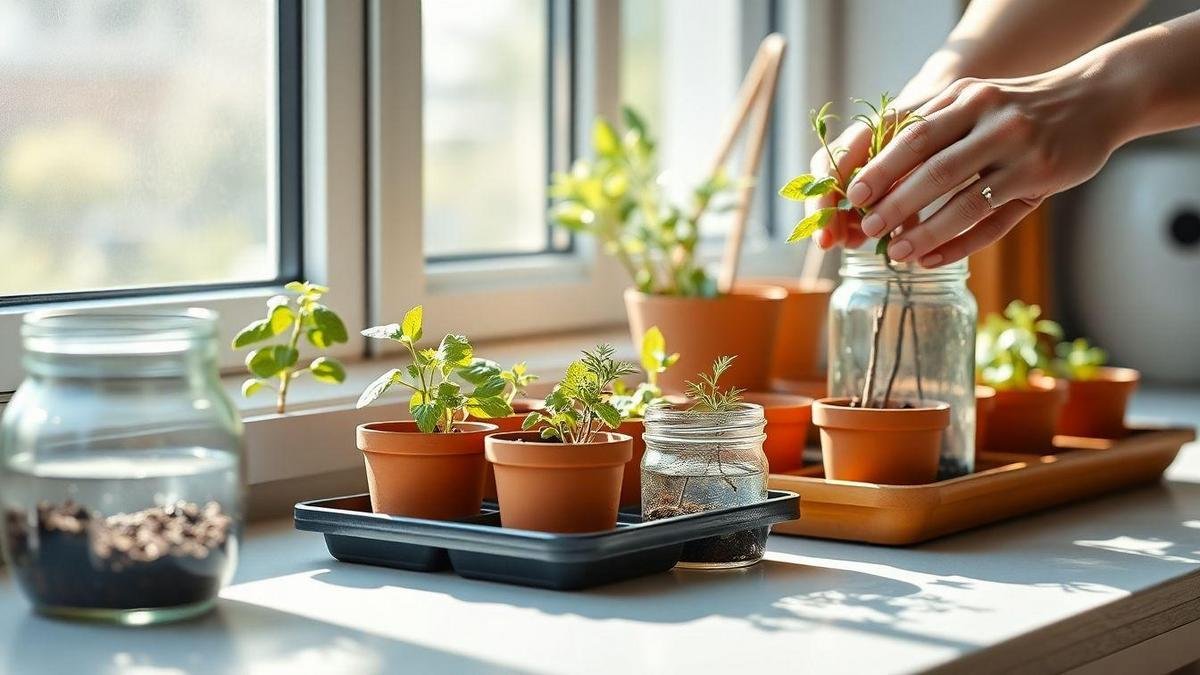
How I start herbs from seeds and cuttings
I start most things on a sunny sill. Seed-starting and cuttings save money and let me control varieties ideal for kitchen herb use.
Seeds — basil and parsley
- Use seeds labeled for indoor sowing. Press into surface; cover lightly.
- Keep mix moist, not soggy. Give bright light; south/west windows work. Add a grow light for 12–14 hours if needed.
- Germination: basil 5–10 days; parsley 14–30 days.
Thin seedlings and pinch basil early to make it bushy.
| Herb | Germination | Light | Water |
|---|---|---|---|
| Basil | 5–10 days | Bright | Keep evenly moist |
| Parsley | 14–30 days | Bright | Keep moist; slower to sprout |
Cuttings — thyme and rosemary
- Cut 3–4″ stems from healthy, non-flowering shoots. Strip lower leaves.
- Thyme: water or soil rooting works (2–4 weeks).
- Rosemary: plant directly in soil (3–6 weeks).
Keep warm and bright, but avoid scorch. Mist or cover for humidity.
| Herb | Best method | Root time |
|---|---|---|
| Thyme | Water or soil | 2–4 weeks |
| Rosemary | Direct soil | 3–6 weeks |
Potting mix components and ratios I prefer
- Potting soil for nutrients.
- Perlite for drainage and air.
- Coconut coir / peat for water retention.
- Coarse sand for grit with rosemary/thyme.
For exact blends and why each component matters, check the best soil mix for container plants and ideas for organic fertilizers and soil amendments to boost seedlings and cuttings.
| Use | Potting soil | Perlite | Coir/Peat | Coarse sand |
|---|---|---|---|---|
| Seeds (basil, parsley) | 3 | 1 | 1 | 0 |
| Cuttings (thyme, rosemary) | 2 | 2 | 0–1 | 1 |
Squeeze test: it should hold shape, then crumble. Add perlite/sand if it stays in a ball.
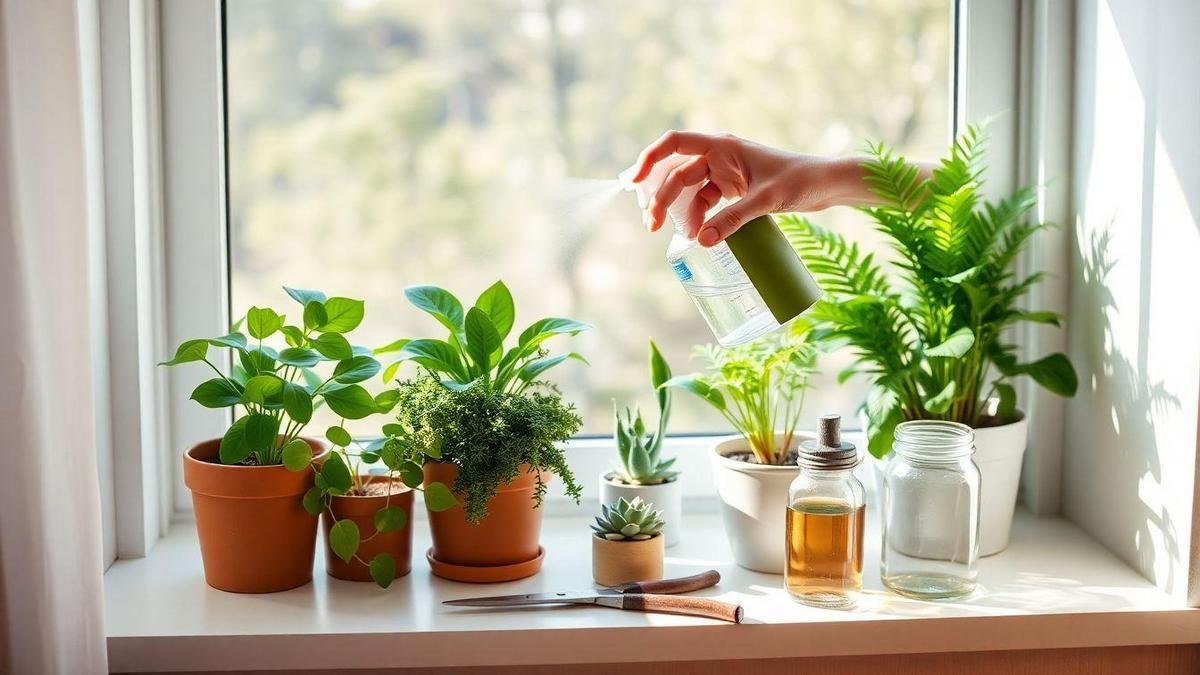
Pests, disease, and seasonal slumps
Common foes: aphids, spider mites, fungus gnats, whiteflies, mealybugs, powdery mildew. Remedies are simple, safe, and coffee-break quick.
| Pest / Problem | How I spot it | Safe remedy | Quick tip |
|---|---|---|---|
| Aphids | Clusters on new shoots; sticky residue | Spray mild soapy water (1 tsp dish soap per liter), rinse after 10 min | Squish small clusters |
| Spider mites | Fine webbing; speckled leaves | Wipe leaves; neem oil weekly | Misting helps; they love dry air |
| Fungus gnats | Tiny flies; larvae in soil | Let soil dry, sticky traps, top-dress sand | Cut watering first |
| Whiteflies | Tiny white bugs that fly up | Yellow sticky traps; blast with water | Vacuuming works |
| Mealybugs | Cottony white blobs | Dab with alcohol on a swab | Isolate plant |
| Powdery mildew | White dusty patches | Remove leaves; spray diluted baking soda mix | Improve airflow |
For natural, effective strategies and product-free options, I reference guides on getting rid of pests naturally and organic pest-control solutions.
Adjusting care in low-light months
Winter light is shy. I slow feeding and watering, move pots closer to windows, or add an LED grow light on a timer (8 hours). Pinch to keep plants compact. Choose compact herbs for small sills: chives, thyme, compact oregano, dwarf basil, and curly parsley. For low-light picks and strategies, see the best plants for low-light gardens.
| Compact herb | Why I like it |
|---|---|
| Chives | Tiny clumps; fast regrowth |
| Thyme | Slow, woody, stays close |
| Oregano (compact) | Greedy flavor, low height |
| Dwarf basil | Small leaves, big taste |
| Parsley (curly) | Tight rosette, fits small pots |
Simple monitoring and prevention
- Inspect leaves weekly, especially undersides.
- Touch soil to check moisture.
- Quarantine new plants for two weeks.
- Wipe dusty leaves; use a small fan for airflow.
- Keep pots and saucers clean; use sticky traps at first sign of flying pests.
- Sterilize tools with alcohol.
If you prefer really low-fuss options, check low-maintenance plants for beginners for similar care approaches.
Why Herbs for culinary use in windowsill gardens are perfect
Windowsill herbs give immediate rewards: fresh flavor, reduced waste, and constant inspiration for cooking. They’re low-cost, decorative, and practical — perfect for renters, apartment cooks, and anyone who wants herbs on demand without a full garden.
Conclusion
My windowsill is a tiny restaurant kitchen: basil, parsley, thyme, and rosemary clock in for flavor shifts and ego boosts. The magic trio is drainage, the right pot size, and watering when the top inch is dry. Seed-starting, smart cuttings, and the occasional grow light keep things productive. Pick compact varieties, tidy regularly, and keep a notebook to stop guessing. Do less, but do it well — and your herbs will make dinner sing.
For more sill-confessions and handy tricks, visit https://myxaro.com and explore practical tips like gardening hacks to save time and money or starting a simple home compost bin to feed your pots.
Frequently asked questions
Q: Which herbs work best for Herbs for culinary use in windowsill gardens?
A: Basil, chives, parsley, mint, and thyme — sun lovers and small-pot friendly. Basil is a diva; chives are low-effort. See more on best kitchen herbs.
Q: How much sunlight do windowsill herbs need?
A: Aim for 4–6 hours of sun. Morning light is best. Add a grow light if natural light is weak; check options for indoor grow lights.
Q: How often should I water kitchen herbs?
A: When the top inch of soil is dry — usually twice a week in warm months. Avoid soggy roots; read more on preventing over- and under-watering.
Q: Can I cut herbs and they keep growing?
A: Yes. Snip a few leaves or cut above a node; don’t strip more than a third. Pinch flowers to keep flavor strong.
Q: Do I need special soil or pots for windowsill herbs?
A: Use a well-draining potting mix (mix with perlite or sand for thyme/rosemary) and pots with drainage holes. Repot yearly and use a saucer. For exact mixes, see the best soil mix for container plants.

